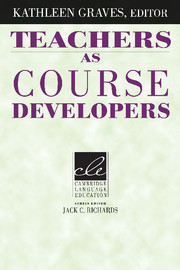Book contents
- Frontmatter
- Contents
- Contributors
- Series editor's preface
- Preface
- Acknowledgments
- 1 Teachers as course developers
- 2 A framework of course development processes
- 3 Designing workplace ESOL courses for Chinese health-care workers at a Boston nursing home
- 4 Designing a seventh-grade social studies course for ESL students at an international school
- 5 Designing an EAP course for postgraduate students in Ecuador
- 6 Designing a writing component for teen courses at a Brazilian language institute
- 7 Planning an advanced listening comprehension elective for Japanese college students
- 8 A curriculum framework for corporate language programs
- Further reading
- Index
2 - A framework of course development processes
Published online by Cambridge University Press: 18 December 2009
- Frontmatter
- Contents
- Contributors
- Series editor's preface
- Preface
- Acknowledgments
- 1 Teachers as course developers
- 2 A framework of course development processes
- 3 Designing workplace ESOL courses for Chinese health-care workers at a Boston nursing home
- 4 Designing a seventh-grade social studies course for ESL students at an international school
- 5 Designing an EAP course for postgraduate students in Ecuador
- 6 Designing a writing component for teen courses at a Brazilian language institute
- 7 Planning an advanced listening comprehension elective for Japanese college students
- 8 A curriculum framework for corporate language programs
- Further reading
- Index
Summary
Curriculum design specialists have developed various frameworks that break down the process of curriculum and course development into components and subprocesses (see, for example, Dubin and Olshtain 1986; Hutchinson and Waters 1987; Johnson 1989; Nunan 1985, 1988a, 1988b; Richards 1990; White 1988). A framework of components is useful for several reasons: It provides an organized way of conceiving of a complex process; it sets forth domains of inquiry for the teacher, in that each component puts forth ideas as well as raises issues for the teacher to pursue; it provides a set of terms currently used in talking about course development and thus a common professional vocabulary and access to the ideas of others. The framework described here, while drawing on the work of others, is cast in terms of my own work with teachers. It is not a framework of equal parts: Each individual's context determines which processes need the most time and attention. Furthermore, the processes are not necessarily sequential but may be carried on in the planning, teaching, and replanning stages of course development.
In Table 1, each component is identified and rephrased in question form to clarify its meaning.
Needs assessment
What are my students needs? How can I assess them so that I can address them?
What is needs assessment, and why does a teacher undertake it? At its most basic, needs assessment involves finding out what the learners know and can do and what they need to learn or do so that the course can bridge the gap (or some part of it).
Information
- Type
- Chapter
- Information
- Teachers as Course Developers , pp. 12 - 38Publisher: Cambridge University PressPrint publication year: 1996
Accessibility standard: Unknown
Why this information is here
This section outlines the accessibility features of this content - including support for screen readers, full keyboard navigation and high-contrast display options. This may not be relevant for you.Accessibility Information
- 9
- Cited by
